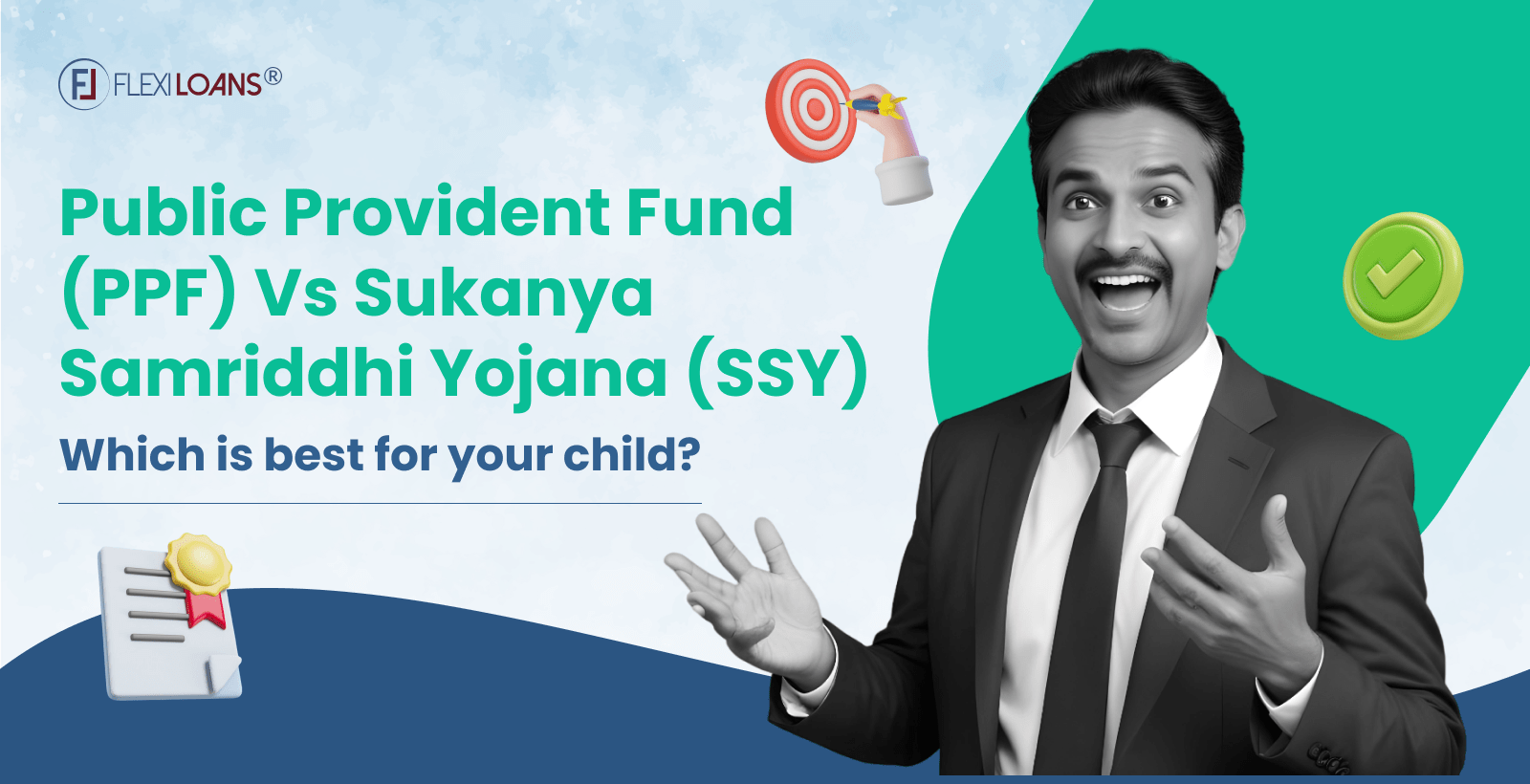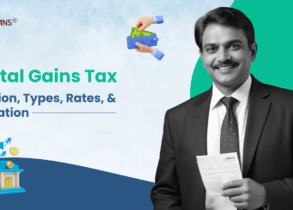PPF vs SSY: Choosing the Best Savings Scheme for Your Child’s Future
Aug 29, 2024

You always strive to secure your child’s financial future. Among the savings schemes available in India, the Public Provident Fund and Sukanya Samriddhi Yojana stand out as popular options. Both provide attractive interest rates, tax benefits, and long-term savings opportunities. However, deciding on the right one can pose challenges. In this blog, you will explore the differences between the Public Provident Fund and Sukanya Samriddhi Yojana to help you make an informed decision.
SSY Vs PPF: What Is the Difference?
While both the Public Provident Fund and SSY are government-backed, they cater to different needs. All Indian citizens can open a Public Provident Fund account, while SSY Yojana specifically caters to girls. Below, you will discover the primary differences between these two schemes to decide which might best suit your child’s future.
Purpose
- Public Provident Fund: You can use Public Provident Fund as a long-term savings scheme aimed at providing financial security, often for retirement planning.
- Sukanya Samriddhi Yojana: It promotes the welfare of the girl child by encouraging parents to save for their daughter’s education and marriage expenses.
Eligibility
- Public Provident Fund: Any Indian citizen, including minors, can open a PPF Account. Parents or guardians can open a PPF Account on behalf of their children.
- Sukanya Samriddhi Yojana: Only girls below 10 years can open an SSY account. A parent or legal guardian must open it on her behalf.
Interest Rate
- Public Provident Fund: The government sets the PPF interest rate quarterly. It currently stands at 7.1% per annum (compounded annually).
- Sukanya Samriddhi Yojana: It offers an 8.0% per annum rate (compounded annually), slightly higher than PPF Best Interest rates.
Tax Benefits
- Public Provident Fund: Contributions to PPF qualify for tax deductions under Section 80C of the Income Tax Act. Both the interest earned and the maturity amount remain tax-free.
- Sukanya Samriddhi Yojana: Contributions to SSY also qualify for tax deductions under Section 80C, with interest earned and maturity amount exempt from tax.
Withdrawal and Maturity
- Public Provident Fund: PPF matures in 15 years and allows extensions in 5-year blocks. You can make partial withdrawals from the 7th year.
- Sukanya Samriddhi Yojana: This scheme matures 21 years from the date the account is opened or when the girl gets married after reaching 18. You can withdraw up to 50% of the balance for educational expenses once she turns 18.
Contribution Limits
- Public Provident Fund: You must contribute a minimum of ₹500 annually, with a maximum limit of ₹1.5 lakh.
- Sukanya Samriddhi Yojana: The minimum deposit is ₹250 per year, and the maximum limit is ₹1.5 lakh annually
Also Read about What is PMEGP Government Scheme
Comparison Table: SSY Vs PPF
| Feature | Public Provident Fund (PPF) | Sukanya Samriddhi Yojana (SSY) |
|---|---|---|
| Purpose | Long-term savings for individuals | Savings scheme for the girl child |
| Eligibility | Any Indian citizen | Girl child below 10 years of age |
| Interest Rate | 7.1% per annum | 8.0% per annum |
| Tax Benefits | Section 80C, tax-free interest | Section 80C, tax-free interest |
| Maturity Period | 15 years | 21 years or upon the girl’s marriage |
| Withdrawal Options | Partial from the 7th year | Partial after 18 years, up to 50% for education |
| Contribution Limits | ₹500 to ₹1.5 lakh annually | ₹250 to ₹1.5 lakh annually |
In-Depth Analysis of SSY Vs PPF
| Criteria | SSY | PPF |
|---|---|---|
| Long-Term Goals | Ideal for securing a significant corpus for your daughter’s higher education or marriage due to a higher interest rate and longer maturity period. | Versatile savings option suitable for various purposes, including retirement, with a flexible maturity period. |
| Flexibility | Limited withdrawals allowed for education or marriage, making it a more rigid but focused savings option. | Offers greater flexibility with partial withdrawals from the 7th year and the option to extend after the initial 15-year term. |
| Interest Rates | Offers a higher interest rate, making it more lucrative for those focused on maximizing returns. | Competitive interest rates are periodically reviewed to align with market conditions. |
| Tax Benefits | Provides tax benefits under Section 80C, including exemptions on contributions, interest earned, and maturity amounts. | Offers similar tax benefits under Section 80C, with exemptions on contributions, interest earned, and maturity amounts. |
| Accessibility and Ease of Operation | Available at many banks and post offices, though it might require more manual effort for deposits and management, especially in rural areas. | Widely accessible with online account management, offering the convenience of opening and managing the account digitally. |
Who Can Open the Account?
Public Provident Fund
Any Indian citizen, including minors, can open a PPF Account Online. Parents or guardians can open it on behalf of their children, making PPF a versatile savings option for individuals of all ages.
Sukanya Samriddhi Yojana
Only girls under 10 years can open an SSY account. Parents or legal guardians must open and maintain it until the girl turns 21. This Yojana ensures the scheme benefits the girl child, promoting her financial security.
Evaluating Risk, Security, and Financial Flexibility
| Criteria | SSY | PPF |
| Risk and Security | Government-backed, offering high security with minimal risk, making it ideal for risk-averse investors. | Government-backed, ensuring stability and long-term returns, suitable for risk-averse investors. |
| Contribution Flexibility | Lower minimum deposit, making it more accessible. You can contribute up to ₹1.5 lakh annually, maximizing tax savings under Section 80C. | Flexible contribution amount with a maximum of ₹1.5 lakh annually, offering substantial tax savings under Section 80C. |
| Premature Closure | Permits closure under exceptional circumstances, like the account holder’s death or medical emergencies, but may involve penalties or lower interest rates. | Allows premature closure after 5 years for higher education or serious illness, with potential penalties or lower interest rates. |
| Use of Funds | Specifically focuses on the girl child’s future needs, particularly education and marriage. | General savings scheme usable for any purpose, providing broader financial flexibility. |
| Impact on Financial Planning | Higher interest rate and targeted approach ensure a substantial corpus for your daughter’s future, making it a focused option for specific financial goals. | Provides flexibility and broad applicability, serving as a cornerstone for general financial planning. |
| Interest Rates and Inflation | Periodically adjusted interest rates offer better protection against inflation, crucial for saving for future expenses like education. | Interest rates are also periodically adjusted to align with inflation, providing reasonable protection against rising costs. |
| Legacy and Wealth Transfer | Managed by the guardian until the girl child reaches maturity, making it a valuable tool for legacy planning specifically for your daughter’s future. | Inherited by the nominee, making it a versatile option for legacy and wealth transfer planning. |
| Educational Planning | Allows withdrawals of up to 50% of the account balance after your daughter turns 18, specifically supporting educational expenses. | Allows partial withdrawals from the 7th year, but does not offer the same targeted support for education, making it more suitable for general financial needs. |
Selecting between the Public Provident Fund(PPF) and the Sukanya Samriddhi Yojana (SSY) depends largely on your financial objectives and your child’s specific needs.
- Public Provident Fund offers a flexible, reliable savings option for various purposes, including retirement planning. It provides tax benefits, stable interest rates, and the ability to manage and withdraw funds with relative ease. If you aim for a versatile savings tool with broader application, PPF might be the right choice.
- Sukanya Samriddhi Yojana (SSY) focuses exclusively on the future of your daughter, offering a higher interest rate and specific provisions for her education and marriage. It uses the funds for her well-being, making it ideal if you want to secure her financial future with a targeted approach.
Conclusion
Carefully consider your long-term goals, flexibility needs, and the specific benefits of each scheme before making a decision. Both Public Provident Fund and Sukanya Samriddhi Yojana are government-backed and offer attractive benefits, but choosing the right scheme will help you achieve the best outcomes for your child’s future.
If you’re also focused on growing your business, consider exploring financing options that can help you achieve your entrepreneurial goals. You can easily apply for business loans tailored to your needs, whether you’re looking for quick business loans to address immediate financial requirements or a machinery loan to invest in essential equipment. For women entrepreneurs, business loans for women offer additional support to drive success.
Understanding business loan eligibility and the business loan documents required will streamline your application process, ensuring you secure the funds you need. Use a business loan calculator to estimate your potential EMI and make informed decisions about your financial commitments. FlexiLoans provides the resources you need to access these loans quickly and efficiently, empowering your business to thrive.
FAQs
Q1. Why is the Public Provident Fund (PPF) considered a good investment?
You consider PPF a good investment because of its government backing, tax-free interest, maturity amount, and competitive interest rate. It’s a low-risk, long-term savings option suitable for individuals seeking a secure financial future.
Q2. Can I open both a PPF and an SSY account for my child?
Yes, you can open both a PPF and an SSY account. While PPF can be opened for any individual, including minors, SSY is specifically for girls below the age of 10. Having both accounts allows you to maximise your savings and secure your child’s financial future.
Q3. What are the documents required to open an SSY account?
To open an SSY account, you need the girl child’s birth certificate, proof of identity, and proof of residence for the parent or guardian, along with passport-sized photographs. These documents help verify the eligibility of the account holder.
Q4. How can FlexiLoans help in financial planning?
FlexiLoans offers a variety of loan products, including business loans, working capital loans, and unsecured loans, to support your financial planning needs. With an easy online application process and quick loan sanctioning, FlexiLoans makes it simple to access the funds you need to achieve your financial goals.
Q5. Is the interest rate for SSY fixed?
No, the interest rate for SSY is not fixed. The government reviews and adjusts the rate every quarter. However, it typically remains higher than the PPF Best Interest rates, offering better returns for long-term savings.
Q6. What happens to an SSY account if the girl child moves abroad?
If the girl child becomes a non-resident Indian (NRI), you can continue the SSY account until maturity. However, no further contributions are allowed after the change in residency status. The account will continue to earn interest until maturity.









